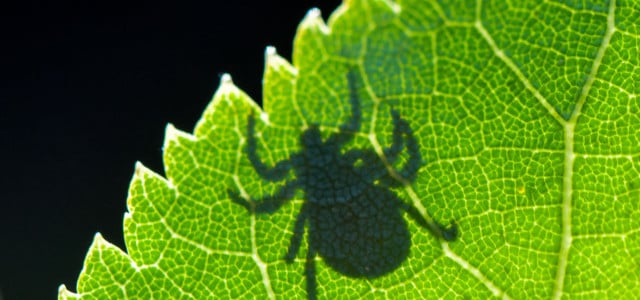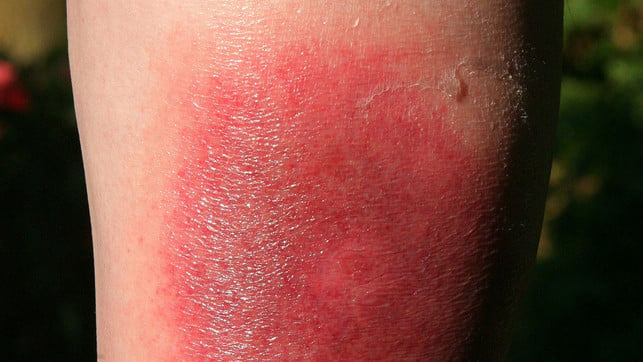
If you are stung by an infected tick, there is a risk that you are infected with early summer meningoencephalitis (TBE) or Borreliosis bacteria. Here you can find out what the typical symptoms for the two diseases are and what to do with symptoms.
The good news in advance: The fact that a tick is put on your body does not automatically mean that it leaves you with an illness. For an infection, the tick must first carry and pass on the bacteria or viruses that trigger this disease.
Diseases that can be transmitted by tick include Borreliosis (also called Lyme Borreliosis or Lyme disease) and early summer meningoencephalitis (TBE). Borreliosis is a bacterial infection that, according to Robert Koch Institute (RKI), can affect various organ systems. TBE is transferred via viruses – it is an inflammation of the brain or the meninges. Borreliosis occurs more often than TBE.
According to current RKI data, only about 0.3 % to 1.4 % of those affected develop actual Lyme disease after a tick bite. At up to 2.6–5.6 %, however, antibodies can be demonstrated against Borrelia – without mandatory disease symptoms. TBE viruses occur mainly in southern Germany. For this purpose, the RKI publishes a map of the main end mandate every year. On average, TBE viruses have 0.1 percent to 5 percent of ticks in TBE risk areas, explains the Robert Koch Institute (RKI).
It is important to know how the diseases show up – and how to protect yourself from them.
What complaints does early summer meningoencephalitis bring with it?
First of all, TBE shows itself through fever, headache and body aches, i.e. a general feeling of illness. The symptoms are similar to those of flu and are often misinterpreted. With the abolition of the symptoms, the disease is survived for many – but not for everyone.
In part of the infected people, about a week later, the meninges, the brain or the spinal cord ignite in a second phase of illness. This can be accompanied by fever, headache and nausea. “Disappets are also often sensitive to light,” says Kristina Huber, doctor in the outpatient clinic of the Department of Infection and Tropical Medicine at the LMU Klinikum Munich.
In the event of a severe course, seizures, paralysis symptoms- such as the arms and legs- and also swallowing and speech disorders are possible. Consequential damage, such as a permanent impairment of fine or rough motor skills, is not excluded. By the way, if you have TBE, you are not contagious.

By the way: Immediately after a tick bite, there is often an itchy redness of the affected area – this is normal. It usually disappears within a few days. What if a red, spreading stain shows itself several days after the tick bite? Then this is a sign of Lyme disease, not for TBE. It makes sense to go to the doctor.
According to the Robert Koch Institute, 686 TBE diseases were reported in Germany in 2024-a significant increase compared to the previous year, in which there were still 478 cases. Almost all sick were not or only insufficiently vaccinated.
Borreliosis: What are the signs?
In addition to TBE, Borreliosis is the second disease that can be transmitted by ticks. Borreliosis can have very different courses. This is because the disease affects various – and often several – organ systems. This can be the skin, nerves, joints or the heart, as the German Brain Foundation explains.
The infection can also be unnoticed. However, if she causes symptoms, the rush is typical.
Recognize typical hiking toys
This is how you recognize the blush (“erythema migrans”): around the puncture site there is a circular reddening with a diameter of at least five centimeters. This can be the case three days after the tick bite, but it can only show up after around 30 days. The reddening is spreading and can achieve a diameter of up to 20 centimeters.

However, not every Lyme disease is accompanied by a blush. According to the German Brain Foundation, this symptom only occurs in three out of four affected people who show symptoms.
Further signs of Lyme disease are fever, chills and/or fatigue. Muscle and joint pain can also occur in the days or weeks after the stitch. If borreliosis affects the nervous system, nerve irritation can occur, feelings of numbness, visual or hearing disorders or paralysis.
Important to know: Lyme disease can have a second phase of illness that sometimes only starts months after the tick encounter. This can lead to meningitis, for example, which is noticeable, among other things, by one or both sides of the face.
I think I’m affected. And now?
If you suspect to be affected by Lyme disease, you should see the family doctor. The good news: The disease can be easily under control with antibiotics, which can also protect against difficult courses.
Precisely because it can take so long for Lyme disease to show up, the German Brain Foundation advises: keep in mind that you have been stabbed by a tick – the best thing is to write down the date.
How can I prevent Lyme disease?
Good to know: it takes a few hours for the borrelia (ie the pathogens of borreliosis) to pass into the body during a tick bite, explains the German Brain Foundation. “Up to 12 hours after the stitch is the likelihood that Borrelia will be transferred, still very low. So if you discover the tick bite during this period and completely remove the tick, you generally do not have to fear Lyme disease.”
It is therefore important to search the body thoroughly immediately after excursions and to quickly remove ticks -for example with a tick card or tongs or tweezers.
The best thing is, of course, when the tick is not given an opportunity to get. Therefore, you should wear long trousers on excursions into the countryside – preferably long sleeves. Anti-tick lotions and sprays can also help to keep the animals off the body. By the way: Unlike TBE, there is no vaccination against Lyme disease.
Read more on utopia.de:
- What is the purpose of ticks?
- Drive off insects: These home remedies help against mosquitoes, wasps and Co.
- Ticking agents for dogs: help these natural means
** marked with ** or orange underlined Links to sources of supply are partially partner links: If you buy here, you will actively support Techzle\.com, because we will then receive a small part of the sales proceeds. More information.